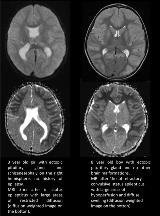Facilitation of Refractory Status Epilepticus and Severe Brain Damage in Patients With Panhypopituitarism and First Time Seizures
Abstract number :
2.102
Submission category :
4. Clinical Epilepsy / 4A. Classification and Syndromes
Year :
2018
Submission ID :
501358
Source :
www.aesnet.org
Presentation date :
12/2/2018 4:04:48 PM
Published date :
Nov 5, 2018, 18:00 PM
Authors :
Matthias Eckenweiler, University Medical Center Freiburg; Jan Schönberger, University Medical Center Freiburg; Hans Fuchs, University Medical Center Freiburg; Mukesch Shah, University Medical Center Freiburg; Janbernd Kirschner, University Medical Ce
Rationale: Panhypopituitarism is a condition of inadequate or absent production of the anterior pituitary hormones, sometimes in combination with a lack of antidiuretic hormone, particularly in acquired cases. Panhypopituitarism can occur isolated as a result of a lack of the pituitary gland, as part of a more complex brain malformation or secondary to acquired brain damage for example after brain tumor resection. Due to the etiology panhypopituitarism can be a co-morbidity in patients with epilepsy. In congenital absence of the pituitary gland symptomatic neonatal seizure as a result of hypoglycemia are well known. Further interactions between the hormonal deficiency, resulting imbalances in electrolytes and glucose levels and seizure activity are unknown. Methods: Review of the clinical database at the department of pediatrics and neuropediatrics at the university Medical Center Freiburg for patients with co-morbidity of epilepsy and panhypopituitarism. Analyses of seizure frequency, responsiveness to treatment, MRI and EEG data. Results: 27 patients could be identified with both diagnoses. Isolated panhypopituitarism was found in 3 cases, associated with other brain malformations in 9 cases and secondary to trauma/tumor resection in 15 cases. Epilepsy was well controlled with one or two antiepileptic drugs in 16 cases, seizures were refractory to treatment in the remaining 11 patients (41%). One patient manifested with epilepsia partialis continua and two with super-refractory status epilepticus without prior history of epilepsy. One of these patients had an isolated ectopic pituitary gland and no cortical malformations. All three patients had bland upper respiratory infections at time of first seizure. In the two patients with status epilepticus glucose levels were low on time of arrival at the emergency department, but consecutive control of hypoglycemia did not interrupt seizures. Both patients developed early substantial brain hypoperfusion and secondary permanent brain damage (Figure 1). Both patients remained in a non-convulsive status despite anesthetic doses of thiopental for several days and survived with severe neurological impairment. Conclusions: We report patients with epilepsy and panhypopituitarism. Similar to other epilepsies 30% were refractory to medication. Without a preexisting history of seizures, 3 patients manifested with severe continuous seizure activity that resulted in unusually large areas of hypoperfusion and brain swelling in two patients and could not be controlled by hormonal substitution. Panhypopituitarism therefore might be a risk factor for sustained seizure activity and resulting brain damage. Funding: None
